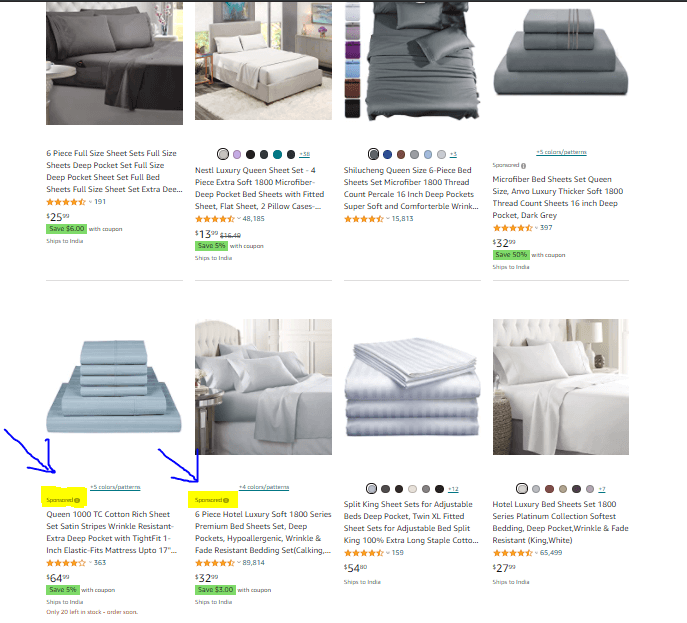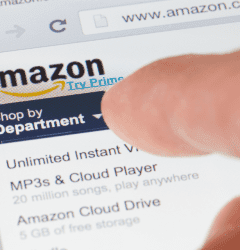This website uses cookies so that we can provide you with the best user experience possible. Cookie information is stored in your browser and performs functions such as recognising you when you return to our website and helping our team to understand which sections of the website you find most interesting and useful.
26 May

Guide to Amazon Advertising: PPC Ads
If you want to excel in your business in the long run, not going online is never going to be an option in today’s world. Today being present online has become a basic sustainability clause for businesses owing to the ever-changing behavior of consumers and the drastic shifts to online platforms for purchase. However, starting an online business is not as exciting and fun as it seems, but rather is a tiring and challenging task for most business owners. When you’re just starting out, you often don’t have any sales momentum. Advertising is a way for you to buy that momentum.
No. We aren’t talking about advertising over Google or any other social media platforms. But rather a platform, where customers are already at the bottom of the sales funnel. Yes, you guessed it right. The Amazon Marketplace.
Despite the seemingly high number of searches on Google, a majority of paid search conversion rates still hover over e-commerce websites. The feasibility of Amazon PPC ads, which targets customers who are at the bottom of the funnel, the conversion rates are sometimes 10x higher. Although these metrics differ widely based on the niche, the average conversion rate on Amazon is a whopping 9.55% today as per a recent study by Adbadger.
While this data is assuring, we have more to back our claim. According to a study by BigCommerce, 9 out of 10 consumers are believed to do a price check of a product on Amazon and more than 50% of product searches start directly from this platform. Such is the potential of the Amazon marketplace that could be tapped optimally if you incorporate a clear marketing strategy for your brand, and that is exactly what you will learn by the end of this blog.
- How can you get started?
- How much will it cost you to sell on Amazon?
- What is Amazon PPC? How does it work? Why is it important?
- Types of PPC Ads and types of targeting
- Targeting and Placements
- KPIs of Amazon PPC
- Bidding Strategies
- Best Practices and Tricks of the Trade.
Let’s jump right into it!
How can you get started?
For you to start selling on Amazon, you need to have access to either of the Selling portal of Amazon – Seller Central OR Vendor Central. The two options majorly differ on the question of who deals with the customer. A seller central is handled by a third-party seller who sells through Amazon while in the Vendor central, Amazon buys the products and sells them forward on its own.
How much will it cost you to sell on Amazon?
The strain on your pocket when opting to sell through Amazon could be very diverse depending on a case-to-case basis. It is usually affected by variables like the selling plan, product category, chosen fulfillment strategy, and many more. The options are flexible, so you can find the combo that works best for you and your goals.
Once you have finalized your selling plan, individual or professional you need to choose from four methods of fulfillment which involve different costs for different product categories. Since there are many parameters involved Amazon provides a detailed charge sheet for your reference, but you need to understand all parameters before making a decision.
Assuming an INR 400 product in the Beauty category, take a look at the following table to get a clear picture.
| Charges | Referral Fee | Closing Fee | Fulfilment Fee | Launchpad Fee | Total Costs |
| Varies By | Category and Price | Shipping method and Price | Shipping Method and Weight/Size | Account Price | |
| Fulfillment by Amazon (FBA) | INR 14.40 | INR 20.00 | INR 80.00 | INR 18.00 | INR 132.40 |
| Amazon Easy Ship | INR 14.40 | INR 5.00 | INR 45.00 | INR 18.00 | INR 82.40 |
| Amazon Easy Ship Prime | INR 14.40 | INR 8.00 | INR 60.00 | INR 18.00 | INR 100.40 |
| Self-Ship (FBM) | INR 14.40 | INR 16.00 | INR 75.00* | INR 18.00 | INR 123.40 |
What is Amazon PPC? How does it work? Why is it important?
We all know that when we are looking for something to buy on Amazon, we select only from listings on the first page, or max we take the pain to go till the 3rd page to compare. With the help of ads, you can select an ideal placement (that we’ll talk about later in this piece) for your products such that it becomes visible to your target audience at the right time and the right place. Here’s where Amazon PPC helps you display your products to your potential customers. Amazon PPC (pay per click) gives you a platform to advertise your products and pay only when a potential buyer clicks on it.
So, how does it work?
Well, the Amazon PPC algorithm works as an online auction of keywords and terms. In the PPC model, the Cost-Per-Click (CPC) on Amazon will depend on the second-highest bidder. Here’s an example to help you understand this elaborately.
Each advertiser submits a default bid (the maximum they are willing to pay) for their ad. The highest bidder (keeping other factors constant) wins the highest ad position and will also pay the highest cost per click but he doesn’t pay the actual bid amount, but an amount $0.01 more than the 2nd highest bidder.

In the example above, Advertiser 3 wins the auction with a bid of $4.00. The cost, therefore, of the click charged to Advertiser 3 will be $3.51- if their ad is clicked upon.
And why is PPC important?
Also since increasing organic visibility and brand value will take time, you can start advertising to be assured that your listing doesn’t get lost in the existing clutter of products and brands. It also helps increase the organic ranking and consequently resulting in higher sales over time.
Types of PPC Ads
Amazon supports a pay-per-click model of payment for its PPC Ads. There are 4 Amazon pay per click advertising available on the Amazon marketplace platform. These are:
Sponsored Products Ads – Sponsored Product ads are keyword-driven ads that allow advertisers to promote their products within Amazon’s advertising infrastructure. These ads usually appear in the search results and on product detail pages. Within search results, the ad can be in between the list of items, at the top as a header, or as a footer to the page. On the product detail pages, this can be used to steal competitor’s customers through carousels and recommended product sections.
Sponsored Brands Ads – By its name it must seem that Sponsored Brands ads are ads for brand building. However, these allow more than just brand promotion. They also allow you to showcase your products to specifically targeted shoppers. This type of PPC ad contains a custom headline, brand logo, and up to 3 products in their ad, allowing you to put forward your brand’s message in front of your customers. These appear in the top spot above Amazon search results and product detail pages and can send shoppers to your Amazon Stores page or a custom landing page specified by you on Amazon.
Sponsored Display Ads – Sponsored Display ads utilize Amazon’s advertising infrastructure as well as advertise on external sites through Amazon Ads. These Ads direct shoppers to Amazon product detail pages. These ads are used to remarket products and showcase the products the shopper has left in the cart or was searching for in the near past. The Add to Cart button is also added to the ads to increase the chance of a conversion from the customer.
Video Ads – Newly available, video ads are present in between the search result pages to attract shoppers with engaging visuals. These are linked specifically to their product detail pages to drive immediate sales through their appeal.
Targeting and Placement
Amazon PPC Marketing allows you to target shoppers based on the keywords they type in the search boxes. While setting up a campaign on Amazon, you need to enter the list of keywords you plan to target. After you provide your list of keywords, Amazon’s algorithm selects them to target people. Amazon allows two ways to select keywords.
Automatic Targeting: In Automatic targeting, Amazon makes the keyword lists and sets relevant to your product and its category on its own with its algorithms. In this targeting, Amazon’s whole database of keywords is used to get the right set of keywords for your product or brand.
Keywords when selected through Automatic targeting are then matched with terms being searched on Amazon search pages. The matching is done by an algorithm that incorporates four approaches to perform this task.
You can choose any of these matching techniques while framing your campaign. These approaches are:
- Close Match: Close match lets you match the keywords as it is. It only ignores the case of letters. It excludes misspellings and variations. For example, “honey” will be matched to “honey” or “HONEY” but not to “honye” which could be a typo.
- Loose Match: Loose match lets you incorporate typing errors by the shoppers. This increases the shopping experience but could crossfire sometimes.
- Substitutes: The Substitute option matches keywords for your product substitutes as well. Like for a search of “chair”, “stool” would be considered as well.
- Compliments: Compliments views your ads to product searches of your product’s complementing products as well. Like when shoppers search for “mobile phones” ads for “charges” would appear.
Manual Targeting: If you choose to target specific keywords or products and wish to select them yourself, you can go with the manual targeting method. Here you can enter as many keywords one by one per line into your campaign manager. Alternatively, you can select products whose keywords you wish to target for a more strategic bidding.
Keywords when selected manually have three options for matching:
- Broad Match: Broad match keywords allow Amazon to display your ad to shoppers on a broad basis. This means that your keywords will be matched to search terms that match your keyword and are also related to your keyword. This could include synonyms, misspellings, and variations of your keyword.
- Phrase Match: Phrase match allows you to narrow your target search terms to specific phrases. It allows you to control word order. It eliminates search terms that insert words between the words in your phrase but allows you to target search terms that include words before or after your keyword phrase. This means it will still target variations of your phrase such as misspellings, singulars, and plurals, stemming, acronyms, and abbreviations.
- Exact Match: By using an exact match, you can narrow down the field of customers to those searching exclusively for your keyword(s). They will add words before or after your keywords and use a synonym, unlike phrase match. Exact matches will certainly lower the number of individuals who see your ad, but those who see your ad are much more likely to lead to a conversion.
Products when selected manually are either chosen categorically or individually.
- Category: When you target an entire category of products.
- Individual: When you target specific products alone.
Negative Targeting
Sometimes you just need your product not to rank for a particular set of keywords, here you can use Negative targeting. Negative targets are used by sellers to exclude unwanted search terms from their ad campaigns. This can help you control your Amazon PPC costs and optimize it for higher returns.
Placement of your PPC ads.
There are 3 locations where you can display your ads:
- Top of the Search: This is the most competitive ad placement and also the best converting. When you bid for this placement, it appears in the first row of the Amazon SERP.

2. Product Pages: These are the placements on the product details page as well as all non-search placements like the add-to-cart page

3. Rest of the Search: This placement refers to the middle and bottom of the first page and anywhere on pages 2, 3, 4 and so on

Your bids will vary depending on the placement you choose combined with the bidding strategy.
KPIs of Amazon PPC
Operating an e-commerce business demands embracing trends. On Amazon, where you have a plethora of data and analytical solutions at your fingertips, sellers and brands can access, handle, and analyze their Amazon seller KPIs effectively. These KPIs allow Amazon sellers and brands to track data and generate an evocative understanding of the prevailing consumer and market behavior. A seller can leverage these metrics to get the insights that align with their long-term and short-term goals. Here’s a list of some of the major KPIs that you should always keep a track of while creating your campaign for higher sales.
| KPI | Formula | Explanation | |
| ACoS | Advertising Cost of Sale | ACOS = Spending on Ad / Revenue through Ad x 100 | Helps you evaluate the profitability of your ads; it also lets you compare the efficiency of your ads to those of your competitors |
| ROAS | Return on Ad Spend | ROAS = ad revenue / ad spend | The inverse of ACoS, it lets you check if your ads are profitable or not. It also checks how efficient your ads are in comparison to your competitors. |
| CPC | Cost per click | Determined through a bidding process | CPC is a general indicator of competition intensity in a category and determines your ad costs. |
| CTR | Click-through-rate | Click-through-rate = number of clicks / number of impressions x 100 | Click-through-rate indicates how appealing your ads are to the potential customers/visitors. |
| CVR | Conversion Rate | Conversion rate = number of orders / number of clicks x 100 | As CVR goes up, so does profitability; It indicates how persuasive your ads and products are to affect sales. |
| BSR | Best Seller Rank | Factors that contribute to BSR are: 1. Current and Historic Sales 2. Product Price Changes and Promotions 3. Competitor Products | It’s an indicator of how well your product is selling on Amazon. The lower the rank, the better it is. |
As Sellers, it is crucial that you monitor these KPIs on a regular basis and ensure that they are aligned with your short-term and long-term goals.
While all these KPIs are interrelated they could be handled simply by taking a few simple steps while setting up your campaign. This can be done majorly by improving your Ad Rank, i.e.the position of your PPC ad on the Amazon Search Result page. The position of your ad highly depends on the relevancy of the keywords included in the ad. This is measured as a product of your bid for that keyword or ad group multiplied by the matched keyword’s Quality Score. Assuming all other factors are constant, the more relevant your keywords, ad text, and landing pages are, the higher is your score and the higher your ad ranking. Higher ad ranking typically results in greater visibility for your product listings due to more clicks on your ads bringing in higher gains for your brand in the long run.
Bidding Strategies
Strategies change depending upon sales cycles and prime sales. However, there are some key strategies available on Amazon that you can choose from to run your product campaign. These three bidding strategies are:
- Dynamic bids- down only:
When Dynamic bidding is chosen, it means Amazon can change your bids in real-time. For dynamic bids- down only Amazon PPC strategy, Amazon will reduce your bids for clicks that may be less likely to convert to a sale, as per its algorithms. This would be done for a less relevant search query or for a placement that doesn’t perform well, etc. - Dynamic bids- up and down:
When you choose the Dynamic Bids- up and down strategy, Amazon will increase or lower your bid prices. It would increase your bids in real-time for bids that may convert more likely into a sale and reduce the bids for clicks that are less likely to convert into a sale. - Fixed bids:
When you opt for a Fixed bid strategy, Amazon will not alter your bid prices in real-time. It will use your exact bid for all opportunities and won’t adjust your bids based on the likelihood of a conversion.
Best Practices and Tricks of the Trade.
Till now you must have understood how important it is to advertise over amazon to ensure long-lasting success for your online business. Amazon provides a plethora of services to help you advertise, which you can opt for in different combinations to best suit your business needs.
As experts of Amazon marketing, we recommend you to start selling by advertising with an auto campaign, collecting the search terms which are working for you, and then taking them to manual campaigns where you can actually change the bids as per your discretion.
But first, you must delve deep and understand your brand’s short and long term goals to formulate a dependable Amazon Advertising Strategy.
Know your budget and goals beforehand so that you don’t overpay and miss out on your profits in an urge to bid higher for your products.
While these are just a few starter tips that might help you kickstart your business, you can always reach out to us for optimizing Amazon PPC for your brand in a way that is sure to give you exponential growth.
Related Post
Industries Served
United States
India













